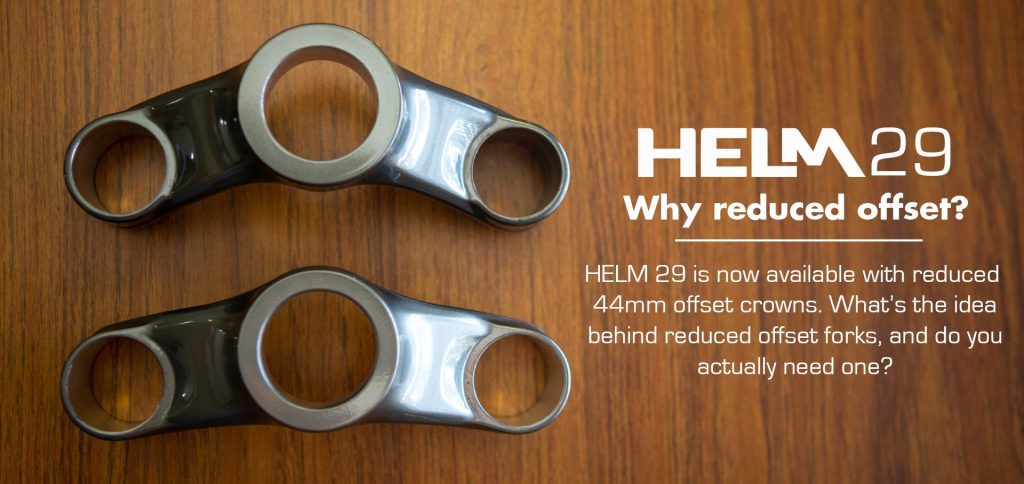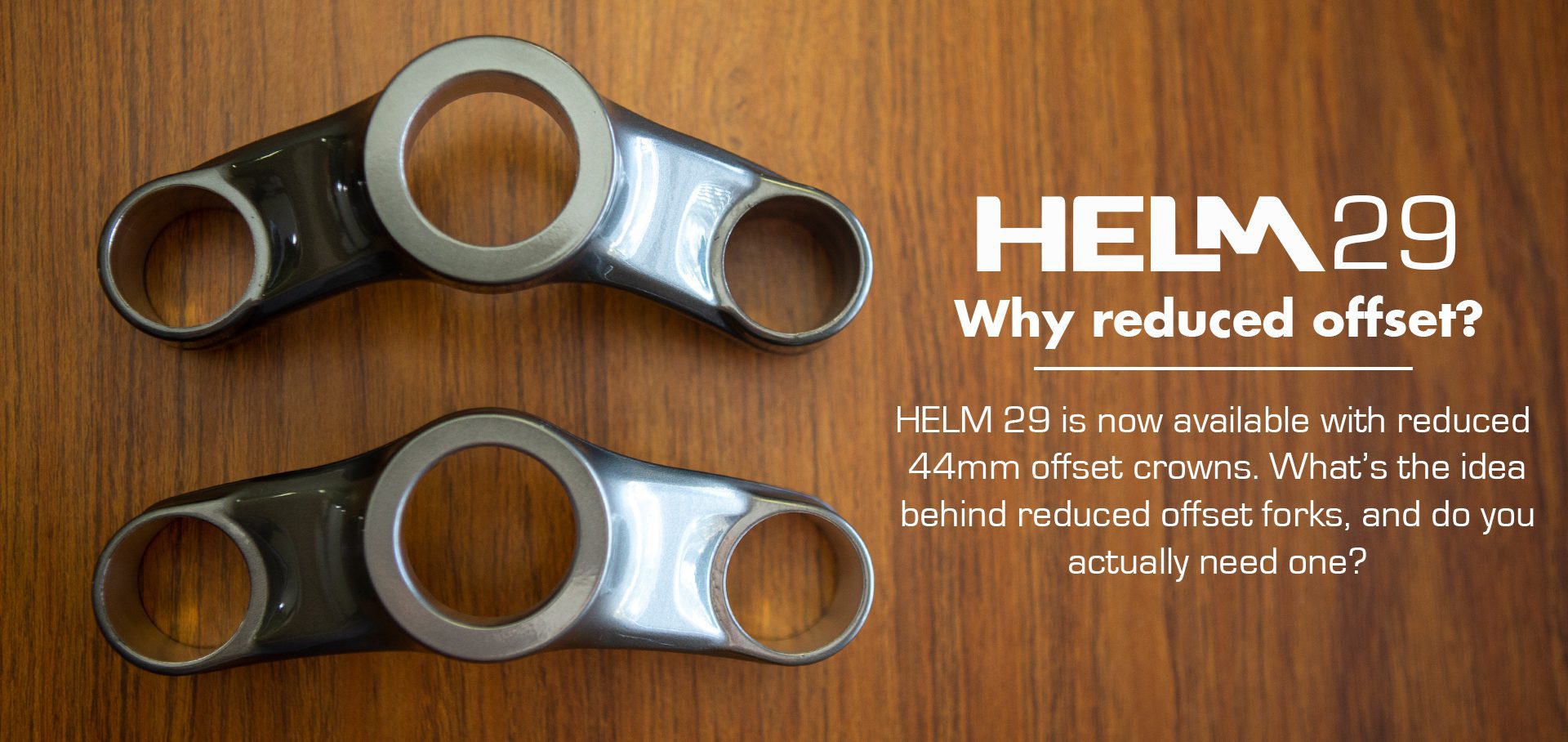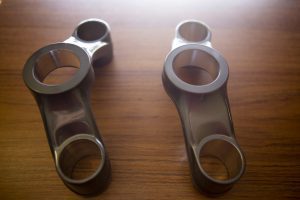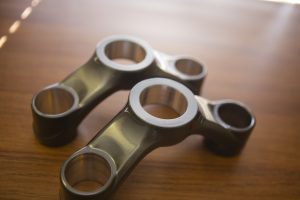PayPal now available at checkout
Free US Shipping On Orders $99+
Previous slide
Next slide


WHAT IS FORK OFFSET?
Fork offset is the measurement of how far the axle (dropouts) sit in front of the bicycle’s steering axis. Rather than pushing the dropout closer to or further away from the fork lowers, Cane Creek lengthens or reduces offset in the fork’s crown. Take a peek at the images below – you should be able to visually see what a difference 7 millimeters makes! (Standard offset – 51mm, reduced offset – 44mm).



DOES FORK OFFSET REALLY MATTER? OR IS THIS THE BIKE INDUSTRY JUST TRYING TO SELL ME ON SOMETHING NEW?
Fork offset definitely matters! Lengthening or reducing your fork offset may alter the steering of your bike, and Original Equipment Manufacturers are purposeful in designing frames that create a very specific ride quality. It’s important that frame geometry be considered holistically: when you make a change to one area, it will affect other areas (think: chainstay lengths, headtube angles, seat tube angles, etc – this Calfee article explains everything nicely). As fork offset decreases, your bike’s “trail” measurement increases, and vice versa. Overall, mountain bike geometries have gotten longer and slacker, which in turn provides increased rider stability, especially in steep and technical terrain. However, the longer the wheelbase, and the slacker the headtube angle, the lazier the bike handles, particularly noticeable in corners. A reduced, 44mm offset fork allows the rider to run a slacker geometry with a similar wheelbase, but still enjoy a stable steering platform without sacrificing traction, stability, and control.
SO, DO I NEED A 44MM OFFSET FORK?
44mm offset isn’t necessarily “better,” but it could improve the handling of the front-end of your bike. Is slow steering bad? Is quick steering better? Is straight-line stability at high speeds desirable, even at the expense of responsive turning? It’s personal preference, it depends on your riding style and skill level, and we recommend considering how you feel on your bike and your desired ride quality. Do you experience “wheel flop”? Does your 29″ bike handle like a bulldozer through corners? Are you fighting against the front-end of your bike? All else staying equal, a change in HELM fork offset could be your solution.
It’s important to note, some manufacturers are specifically designing frames around reduced offset forks (like Transition’s Speed Balanced Geometry), so offering HELM 29 Air and HELM 29 Coil in a reduced offset (44mm) allows riders a premium upgrade to Cane Creek suspension while maintaining the feel originally intended by product designers.

WHAT ABOUT STANDARD 51MM OFFSET FORKS? GIVE IT TO ME STRAIGHT.
Again, it’s all personal preference. Here’s the skinny: 51mm offset reduces “trail” and adds turning agility, while 44mm offset adds “trail” and adds straight-line stability, especially at high speeds. Even if you ride a bike designed for a 44mm offset fork, you won’t kill your ride experience or bike geometry by running a longer offset fork, and vice versa. But changing the fork offset on your bike will definitely change how it handles.
What every article seems to dance around, yet what every reader wants to know is: How is this going to feel? There are a too many factors at play (fork length, wheelbase, tire choice, etc.) and considering bike geometry holistically is very important. Our opinion is: a reduced offset fork may make your long and slack bike have improved handling, which feels “slower” at high speeds (less twitchy), with more stability and smoother handling. MBR further suggests, “Lots of trail [from a reduced offset fork] results in more stable steering but it also results in the front axle being a bit closer to you. So for all-out straightish speed sections the bike will feel shorter. But on twisty hairpins in steep terrain the bike will carve calmer and hold its line better…. A bike feels great when descending if it has steering that is stable at high speeds and when in the turns. You get that from having a large trail figure, something you can achieve either by running a shorter offset or making the head angle slacker.”
Cane Creek is committed to offering products that allow each rider to fine tune his or her ride experience. Now HELM forks have yet another feature to help you make your ride your own. If you don’t feel confident making a decision between these two offsets for your bike or riding style, we recommend contacting your frame manufacturer for advice.
Edited 10:20am – March 20, 2019
Editor’s note: We received an email from Knolly Bikes indicating that some of our content was incorrect. Knolly states on their website: “With a longer offset (51mm) the bike corners better in tight singletrack and has slightly quicker handling but it gives up a bit of stability at high speed. In the shorter offset (42 to 44) the bike is more raked out so it is more stable and performs better at high speeds but in tech climbs, switchbacks, and slower stuff, the bike is a bit more to get around and the front end can feel floppy. Depending on travel, a shorter offset will change the wheelbase between 5-7mm which amounts to an almost insignificant half a percent (0.5%) of the total wheel base.”
Of course, this caused us to second-guess the information originally published, so we took it to two of our engineers, Jim & Sarah. We’ll admit: we struggled with the numbers, we modeled it in CAD, we read more articles, we used several “phone-a-friends,” and we talked it out for an hour… and here’s what we came up with:
We originally published: “Again, it’s all personal preference. Here’s the skinny: 44mm offset reduces “trail” and adds turning agility, while 51mm offset adds “trail” and adds straight-line stability, especially at high speeds.
This was incorrect, and the article above has been edited to reflect this correct information: Here’s the skinny: 51mm offset reduces “trail” and adds turning agility, while 44mm offset adds “trail” and adds straight-line stability, especially at high speeds.
Thank you to Noel at Knolly for bringing this to our attention. However, we maintain that it really comes down to personal preference and ride quality. What every article seems to dance around, yet what every reader wants to know is: How is this going to feel? There are a too many factors at play (fork length, wheelbase, tire choice, etc.) and considering bike geometry holistically is very important. Our opinion is: a reduced offset fork may make your long and slack bike have improved handling, which feels “slower” at high speeds (less twitchy), with more stability and smoother handling.
Monday: 10:00 am – 5:00 pm
Tuesday – Thursday: 10:00 am – 7:00 pm
Friday: 10:00 am – 5:00 pm
Saturday – Sunday: Closed